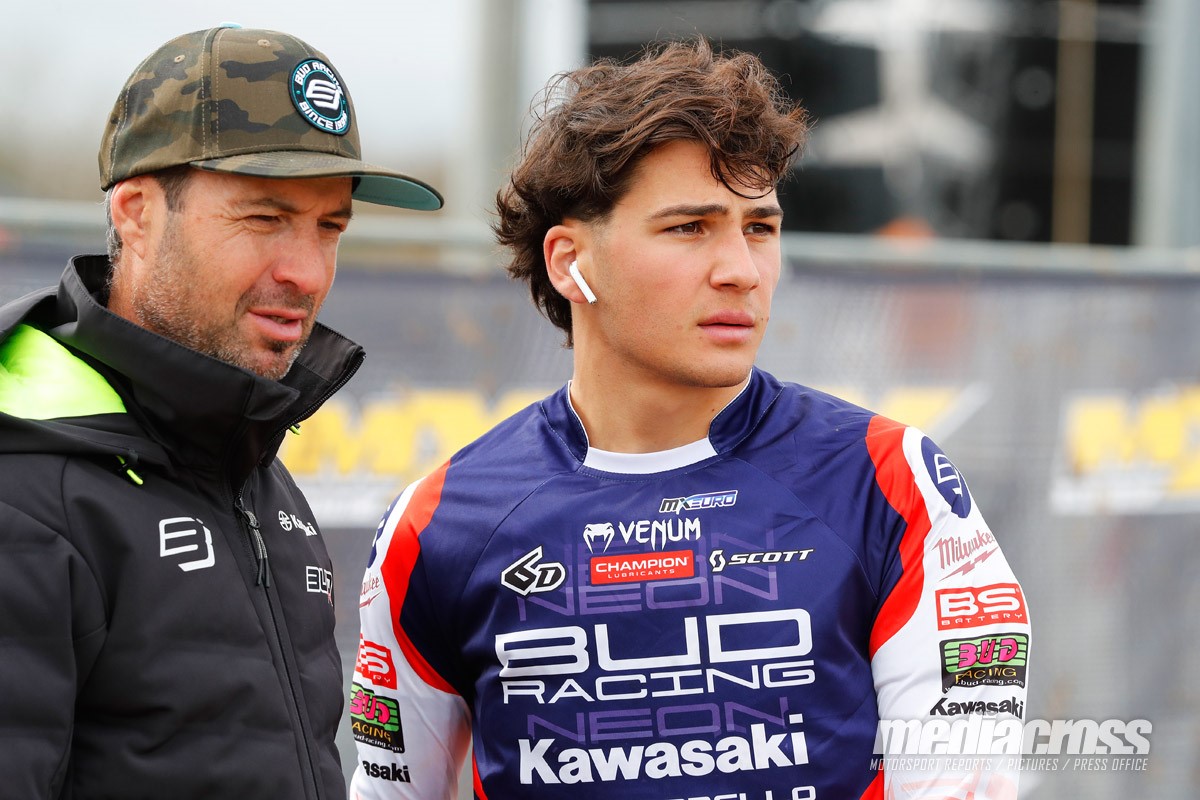Australian company SX Global caused a stir with the announcement of their ambitious plans for a revitalised FIM Supercross World Championship and how a big American sport can finally cross international borders. We decided to ask how the series – with its radical team franchise structure – can work…
By Adam Wheeler,
When Feld Motor Sports cast off the weak shadow of FIM World Championship sanctioning status for the Monster Energy AMA Supercross series last year it looked like the prospect of a ‘SX world title winner’ would fade into the light. Every 450SX/premier class Champion since 2003 has also been a ‘World’ Champion, even though Supercross has not moved outside the boundaries of North America. The last ‘true’ attempt of giving a sport that originated in 1974 some international scope came with two rounds in Spain and Holland. Heath Voss was the last #1 for scoring points outside of an American event.
For what seems like an eternity, AMA teams and riders have been locked into a 29-race agenda running from January to September (discounting other events such as the invitational Monster Energy Cup). 17 Supercross and 12 motocross weekends mean not much room for anything else including travel, injury recovery and training and testing for the following season. Some have used established international meets such as the Paris, Geneva and Australian Supercross to test and earn. Others, burned out, have retired before reaching their late 20s.
Supercross-only deals or arrangements by riders have become more common but still not that prevalent as teams and manufacturers stay loyal to Lucas Oil AMA Pro National motocross. It’s also a struggle to justify just five months of hardcore SX competition. And AMA Supercross is hardcore, often involving 17 fixtures in 19 weeks and across the breath of the USA.
SX Global won the FIM tender for the world supercross rights in November but the prospect of another SX contest did not create large ripples. The frantic schedule of AMA teams and their priorities for the American subsidiaries and sponsors that were paying for national not international success tempered expectation. There was more a sentiment of exaggerated ‘good luck!’ from those within the sport. Supercross has such strong U.S. roots that many international racers have been deterred from the AMA cauldron due to the advantage young Americans have gleaned from the cultural acceptance that ‘SX is the place to be’. Where the bigger dollars are earned and where hitting a supercross track is often the plan for youngsters. There are always exceptions that excel – the Pourcels, the Musquins, the Roczens – but it still took MX2 GP winner Dylan Ferrandis more than two seasons before he won a title in 250SX. The idea of world supercross without the already maxed-out stars of the sport could mean a diluted show.
SX Global is formed principally by President Tony Cochrane, Adam Bailey, the MD of Motorsport and Commercial MD Ryan Sanderson – a combo that had enjoyed acclaim in Australia for the blossoming V8 Supercars series and the Australian Supercross dates. They outlined their plans in March 2022 and suddenly grabbed a lot more attention. The FIM Supercross World Championship would embrace a franchise structure with 10 teams awarded places and their costs paid for fielding two riders in 450 and 250 classes. The teams would be collaborators in a spectacle and an entertainment brand. Big numbers like 50 million dollars over five years emerged, even though the full outline of costs would need a more concise breakdown. However, the fact that a promoter incentivising teams to compete by paying them to be there – similar to the Dorna/IRTA agreement for satellite squads in MotoGP – was a radical shift for both supercross and motocross and at a time when crews are struggling to muster the fees and prices for year-round racing.
The experimental nature of SX Global’s vision (can supercross really be transplanted to international cities? The sell-out of the annual Paris SX – who, to-date, will not join the world championship after an agreement could not be found with SX Global – indicates there is potential) means there are still doubts over whether international SX can succeed and whether it can endure as a creditable championship. SX Global are hot on the glitz of the sport and how it can be mixed with other sideshow opportunities, which only increases the sense of the ‘unknown’ but then also raises hopes that it might just work. Seeing the interest and market for motorcycle racing in South America and Southeast Asia then the prospect of teams representing ‘Honda’ instead of ‘American Honda’ in these fecund territories raises some decent questions.
Starting with five rounds already in 2022 and rising to ten in 2023, the SX World Championship could potentially offer the first real, solid avenue for dirt-bike racers to become well-paid full-time supercrossers. It could de-Americanise, even become more of a solitary discipline.
The possibilities have SX Global heading in a dizzying upward spiral. The group were able to secure the powerful backing of Mubadala Capital (with over 240 billion dollars of assets) which opens doors and immediately creates a financial cushion to make their ideas more achievable.
SX Global have the backing, at least in the short-term, and they certainly have the spirit to accompany their vision but World Supercross lacks integrity and that’s why their first moves have to be right and have to be sensitive. They want the fans and the audience but they also need the participants.
While Bailey is taking care of the sporting side and the selection of the ten teams that will jump into World SX, Sanderson is putting the operational and business puzzle together. Riders and teams have been persuaded – or leveraged – to enter SX or MX races in the past thanks to a big cheque or a sponsor waiving an obligation clause of a contract under their noses but it won’t work for the scale of the new world championship. Bailey has to confirm the cast, Sanderson has to ensure that the championship ploughs out of the gate at the same speed as the participants. We decided to ask him, via a long and interesting Zoom call from Australia, just how that will happen…
Outline your role in SX Global and will the FIM Supercross World Championship be tougher than anything you’ve done before purely because of the international scope?
I’m the commercial MD, so in charge of a lot of the broadcast media and revenue generation for the business, like sponsorship, merchandising and broadcast rights – eventually – and then other streams like gaming and things like NFTs. This is the most exciting career opportunity I’ve ever faced, mainly because of the people we’re onboard with. An example being Tom Potter who is the CEO of Rush Sports Entertainment who have brokered over 700 million dollars in sports sponsorship and commercial deals in F1, Indycar and Formula E. He’s been in F1 for more than twenty-five years and has a very promising international commercial network. Then there’s Tavo Hellmund who is one of the founders of COTA and helped broker the connection between F1 and the U.S. such as the Mexican Grand Prix and he’s consulting on the Miami F1. Adam and I started an agency about ten years ago and created the Aussie SX Open in 2015 with four events in Sydney before going to Melbourne in 2019. We grew them each year. We started with around 22,000 in attendance and grew it to 27,500, which was basically a sell-out in two nights before having huge success in Melbourne. We also ran events in Auckland, which was the largest SX meetings they’d ever had. We sanctioned that with the FIM and in 2019 we started exploring other Asia venues and opportunities and we were close to Singapore as well as Thailand and Japan to see whether we could grow with FIM Oceania sanctioning. Fast-forward through the pandemic and with Feld releasing the SX rights and that quickly turned into a world championship possibility. We’re passionate followers of the sport and it was really exciting. We quickly had to build a team around us and that’s when we got introduced to Mubadala Who have made some incredible sport and entertainment investments over the years. Their networks across the globe are unbelievable. We can get in front of pretty much anybody and its enabled us to scale-up quickly.

It must have been a real hustle to get the structure and support to be able to confirm the World SX deal?
Yes, it was incredible. To be honest with Mubadala we didn’t even meet in person to confirm this deal because the time frame was so short. The rights came up in May, we presented to the FIM in August, they did a full global tender in September and we were awarded the rights in November then we closed with Mubadala in December. They were only going to come onboard if we had the FIM World championship rights. They wanted a true world championship and they can see that the opportunity with supercross is immense because you can visit world class stadia, add music, entertainment and do what you want in the venues. We believe SX can be very aspirational and could be the next MotoGP as one of the most valuable motorsport properties in the world. It’s a dream to align like that.
Did Mubadala have any concrete expectations from you, the sport and the series? And are they speculating short-term or reasonably long-term?
Well, with the FIM it is at least a ten-year deal with an option to go to twenty. That’s an important commitment for us but also very important for Mubadala. We are all very aware that this is going to take several years to grow and we’re in it for the long-haul. They have given us enough capital and support for at least the next five years and that’s why we were able to announce the investment to the teams, the structure and the logistics. It means for five years we’re able to put a flag in the sand and look to a long-term commitment. We all believe that the sport should be global. We know history is against this and supercross has never really been giving an opportunity. This is very unique; arguably a ‘once-in-a-lifetime’. Whether we’re involved or not: the sport deserves to go global. It’s a special motorsport property because of its base in stadia and being able to captivate fans that way. We can choose from any rugby, soccer or NFL venue and arguably we can do cricket, baseball and different places all around the world. At the moment we’re talking to almost 30 different cities and possible governments about the future and these events. It’s been really positive, on a global level, how much interest we’ve had. We want five events this year and expand to ten next year and then grow. It’s exciting to have that many cities ‘invested’ into this new ‘content’ that’s coming. A lot of people want to see sports, entertainment and events come back. I think the general public want that as well. In somewhere like the UK we’ve seen a huge uplift for the music-entertainment business and promoters generally really want to come back. Some of these race events in various cities could be hosted by music promoters that want to give supercross a dabble or mix acts and racing which would be like a new product for them.
The reaction to news of the series seems to be one of curious positivity but there are two big issues: 1) making this championship fit into what is already a very busy American or international calendar for the Pro racers, and 2) pure logistics. Feld are moving around the US and working with dirt that is packed and unpacked each year and the process of taking over stadiums is a smooth operation…
Sure, very relevant points. The opportunity to crown world champions in supercross is something we’re passionate about and that’s what we’re committed to. Riders are going to have to make a choice, whether it’s MXGP or AMA indoors or outdoors. We’ve already come out and said that for the foreseeable – at least for the next five years – we’ll run outside of the AMA Supercross championship to enable riders and teams to have supercross-only careers. The AMA will run January-May and we’ll respect that championship with a gap for those that want to do the Supercross World Championship to have time to rest and have a break. We’ll also be mindful of the AMA series scheduling when we end our season. In the years to come and when we’re a longer championship we expect to be racing from July to November, possibly late June, but never encroaching and allowing riders with injuries to heal. What motivates most is the talks we’ve had with riders that want to do supercross only. The way the trend has gone motocross has kinda been forced on these guys. The commercialisation of the sport and opportunities for the riders and agents and the team to make more money internationally is extreme, compared to remaining in one country all year. It’s huge. We’ve seen in F1 right now that the commercial and sponsorship landscape is perhaps the best it has ever been. Red Bull Racing are signing multi hundred-million dollar deals, with Oracle as an example, and the teams are inundated with requests. It’s a very strong position globally. Sport as a property and a business – and where this is relevant is in our new franchise model – has never been better or been going for big multiple deals. The teams that will get involved [with SX] with these franchises will basically pay pennies on the dollar because they will get funded by us with enormous signing and appearance fees. We take the freight and logistics off their hands. We cover the costs of travelling around the world. The beauty of this – like MotoGP and Speedway – is we can freight them pretty easily. It’s certainly not as challenging as the material other motorsports have to carry. There is still a very large operational and logistical cost but it’s one we’re committed to because we believe in the positives of supercross being a world championship and in all these amazing cities around the world. Whether it’s from Barcelona to Dubai or London to Las Vegas and then to Jakarta we’re ready for that. For the riders it’s obviously a great chance to race supercross all year around. Like you see in MotoGP, for example, we’ve got have riders from Spain for Spanish fans to really get into the sport. We’d like to have riders participate from all over world and that’s why we’ve structured this wild-card model in 450s and 250s, wherever we go there will be opportunities to qualify for that or it will be at the promoter’s discretion as to who we all believe will be the most popular or the best person to compete. Interestingly, we’ve had a lot of interest from MXGP teams. This funding and financing model is not unique to motorsport but it is unique to motocross and supercross, so considering this franchise could be sold by them further down the road at ten or fifteen times more, then it’s an exciting business model as much as it is an opportunity generally to be involved in a world championship. We’ll crown riders, teams, manufacturers and that [team] franchise will have value with success. There have been great rewards with things like the Charter system that’s been introduced to NASCAR, since they capped it then it’s allowed people like Michael Jordan to invest in a team and the values have increased. We’ll only have ten teams, very limited. It will fill quickly and, similar to venues, we’re already had a lot of interest for Adam to select. Then it’s about getting board approval for the riders they’ll have and present it like a business case: who will be financially viable? Where are they based? What riders are coming from what regions? It will be very closely watched because it is very important for success. MotoGP has probably done it the best because they have invested in international riders.
What’s your opinion on commercial event ‘architecture’ now? The perceived wisdom for decades is that ticketing was the main influx but many high-level motorsport races have government backing for finance. How vital are arses on seats for success in 2022 and the future?
It’s a good point. The interesting thing is that we can just sanction an event to a promoter for a fee and then just arrive and do everything for them with the riders, teams, set-up, track build. A music promoter like Live Nation could just ‘buy’ an event of the world championship in a region of their choosing. Do the stadium deal, integrate music into it if they want, sell the tickets and work on the government and tourism money. When you are bringing a world championship to a city or tourism body and you are willing to work with them and the riders [promotionally] and broadcast it then it is very exciting to have that. I know I’m stating the obvious here but it’s of interest for them [governments or cities] to have events in stadia where they don’t need huge amounts of capital investment like you’d need for a motorsports or street circuit. Being in stadiums is a lot more affordable for governments. To answer your question though, it is probably a hybrid of: government backing, sponsorship, the ability to sell tickets and the ability to commercialise in other areas like merchandise. Merchandising, as an example, for a business like Feld and all the acts that they have on their roster means they could arguably make more from that than from ticketing. In general, there are more revenue streams growing inside of sports, and with our model merchandising and team and rider IPs where we’d be looking to do things like royalty shares means there will have more ways to earn other than just appearance fees and prize money. We feel it’s a fair model and not that different to other successful motorsports and other sports around the world but it does seem unique to supercross. You have a sport that is nationally successful and has a younger audience and fanbase than most other fanbases around the world. Our average audience is 35 years of age. So, you have a sport that captivates youth and millennials and generation Z. That’s exciting for a lot of promoters and sponsors, certainly governments. These are events that people will travel and fly in order to attend and then mix it with a city-stay. Inside a stadium we can do what we want. That includes incredible activation and engagements and provisions for families and kids. We are going about this with a new approach and don’t only expect to attract endemic supercross and motocross fans around the world.
Supercross is an American sport so is supercross on an international level going to need excellent PR to sell it in a big way?
Tony Cochrane bought Australian V8 Supercars for 55,000 and grew it to a 310-million-dollar business before selling it to a private equity firm. This is significant growth and the teams all benefitted from that franchise model. The biggest level of success came through building signature events with major music acts and other entertainment that was hinged around the sport. It broadened the appeal. If he did a normal V8 supercars event at a normal circuit he might get 50,000 people over three days – even the MotoGP at Phillip Island might get 30-40,000 fans – but if he did it in Melbourne in the heart of the city and had acts like Guns N’ Roses then he’d pull in 300,000 over four days. The most successful motorsport events were built around music and entertainment. The Melbourne F1 this year has a great line-up and the Singapore F1 is a good example of having more [in the] music and entertainment than the race itself. We see this chance of being in the stadia and having controlled environments and amazing production opportunities. A stage can be used in the intermission or at the end of an event. We want new people to see this amazing sport. We’ll be doing everything that we can with race formats and entertainment to make it appeal to new fans. The reason we have this confidence is because we have seen it in Australia where we grew it from 22,000 to 35,000, which doesn’t necessarily seem like a lot but for an exhibition event when you are generally only bringing over 4-5 Americans it’s quite significant for a sport that isn’t hugely popular in Australia. We saw the audience and found out that only 30% of that 35,000 was actually into motorcycling. 70% were coming from an entertainment perspective and 40% of that total would consider getting into motocross or consider buying a motorcycle as a result of seeing the sport. We were like ‘if we can do that in Melbourne in Australia then why not around the world?’. What also gives us confidence is events like Nitro Circus – which has had a lot of success but is essential FMX and pyrotechnics and entertainment – well, what if you could combine a world championship series with bits of Nitro Circus and elements of other sports and events? Supercross is a very exciting motorsport property. All the runners line up without a real advantage, which is the case in most other motorsports. Even if you are the fastest guy it’s clear you don’t have that much of an advantage and that’s exciting to watch.
From a commercial point of view for a motorsport event in 2022 – and moving forward – is a live television package still an essential component? Or can it be chopped into social media and online chunks and snippets? Can you be more diverse with your output? After all TV rights sales could be difficult to shift for a niche dirtbike series…
Excellent point but fortunately for us being in a stadium means that broadcast costs are easier compared to a long, remote circuit. We don’t feel like it is an expensive sport to broadcast in general in comparison to signature street circuit events like Supercars or Formula One or longer format tracks for MotoGP. They have more cameras and operators and the production is undoubtedly more expensive. To come back to your point, it will be a mix of everything; there will be a live broadcast, highlights, snippets, social media content and longer series lifestyle programmes. We’re motivated to do something that has obviously been successful for Formula One, and many sports are now adapting to follow these ‘Drive to Survive’ stories. Another reason why supercross is so great is because the athletes are so aspirational. They are risking their lives and have to overcome big challenges and injuries. There is always that natural drama and, at times, devastation which is gnarly but something that captivates viewers. These guys are elite with their fitness and they are incredibly talented. You don’t even need to ride a motorcycle to see how cool it is. There is an action sports appeal to it. We will be investing very heavily in broadcast innovations that have not been seen before in this sport, particularly supercross. We’re excited about that. Supercross hasn’t seen much innovation due to the technology and the limitations of the sport itself. We’re working closely on that and how we can broadcast it differently. We’ve seen a lot of sports doing amazing things to attract new fans through broadcast innovation and we’re motivated to do the same-
Can you give a small example? Are we talking drones or onboards?
We’re going to make some announcements in the coming months…but you’re on the right track. Sport is still one of best things for broadcasters globally. You cannot beat live sport for viewers because you largely don’t know what is going to happen. It’s unpredictable. It’s still incredibly popular around the world and some of the biggest broadcast deals are still linked with sport. But, like you said, we need diversity and to make sure we are reaching all kinds of different platforms. We all consume sports in different ways, whether that’s on a phone, a TV or computer or Apps. Still, being broadcast on free-to-air TV is very important for sponsors and it’s also important to be in pubs and sports bars around the world. It’s the best way to be seen and to be prominent. For revenue, we’re more focused on audience and the respect towards the platforms that we’re on commercially – as opposed to the revenue that comes from it – but there are still ways to make money from those broadcast rights. That’s a much as I can say right now without revealing what we have planned.
Supercross and motocross have been very intertwined for many years. Could your series cause a split? Can it create an independent discipline and breed of supercrosser? It will be a specialty that is not just American. You could have quite a responsibility on your shoulders through the opportunity…
Definitely and that will come with challenges because we are doing things differently. I won’t say anything about tracks or get into specific sports but when we were building our circuits in Australia we were focused specifically on rider safety and making sure as many riders could get back to the paddock in good health because the last thing we wanted was riders to be injured before they attempted the AMA series. For the world championship, we will need a world championship spec circuit while having the potential to lower injuries and risk for the riders. Nobody wants to see the amount of injuries that have happened for quite a while. We need to strike a balance between the sport being elite and incredibly respected for a true world championship but also to keep it close and as safe as possible. We know it is not a ‘safe’ sport but we have to do what we can with the tracks we build. I’m not saying it’s going to be a flat track without any jumps but the balance has to be right. It’s going to be important. I think we did it well in Australia and we can apply it to the world championship. If we can do this it will be easier for riders to potentially change disciplines or get involved.
Interview: Adam Wheeler


















